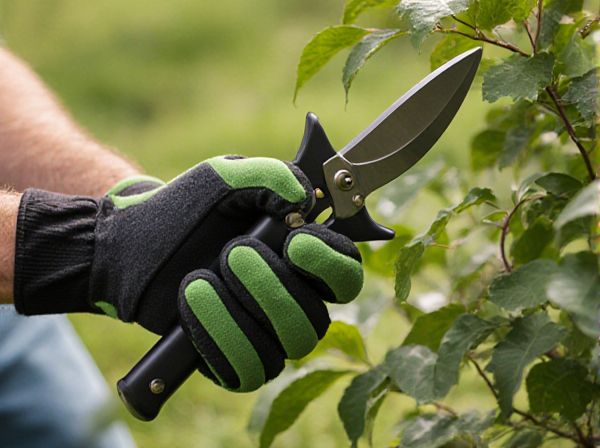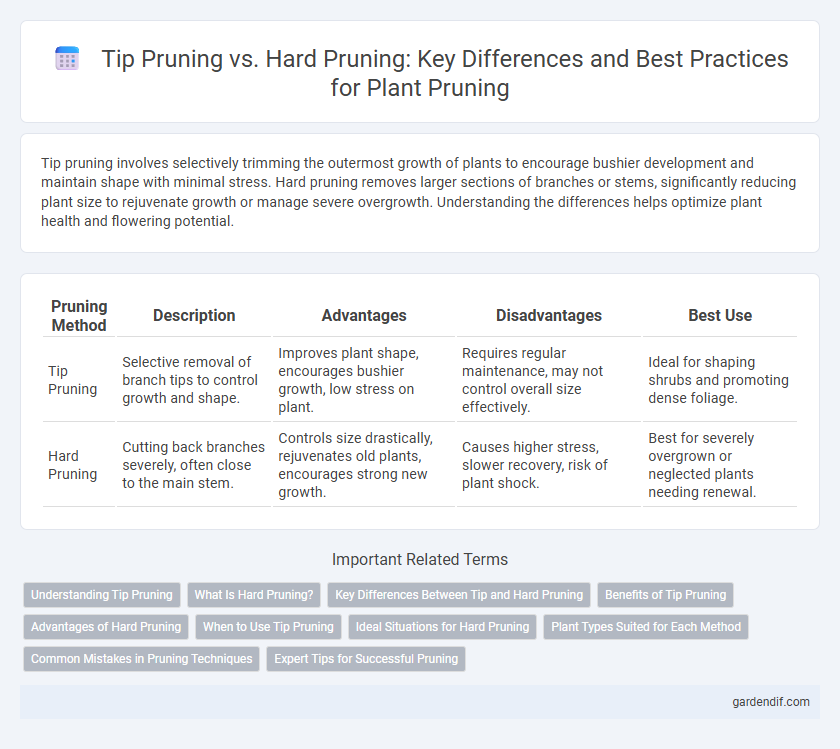
Tip Pruning vs Hard Pruning Illustration
Tip pruning involves selectively trimming the outermost growth of plants to encourage bushier development and maintain shape with minimal stress. Hard pruning removes larger sections of branches or stems, significantly reducing plant size to rejuvenate growth or manage severe overgrowth. Understanding the differences helps optimize plant health and flowering potential.
Table of Comparison
| Pruning Method | Description | Advantages | Disadvantages | Best Use |
|---|---|---|---|---|
| Tip Pruning | Selective removal of branch tips to control growth and shape. | Improves plant shape, encourages bushier growth, low stress on plant. | Requires regular maintenance, may not control overall size effectively. | Ideal for shaping shrubs and promoting dense foliage. |
| Hard Pruning | Cutting back branches severely, often close to the main stem. | Controls size drastically, rejuvenates old plants, encourages strong new growth. | Causes higher stress, slower recovery, risk of plant shock. | Best for severely overgrown or neglected plants needing renewal. |
Understanding Tip Pruning
Tip pruning selectively removes the growing tips of plants to encourage bushier growth and increased branching, optimizing light exposure and air circulation. Unlike hard pruning, which cuts back large sections of a plant to its main structure, tip pruning is less stressful and promotes continuous development. This method enhances overall plant shape and productivity by maintaining a balanced canopy.
What Is Hard Pruning?
Hard pruning is a technique in machine learning where entire neurons, filters, or layers are permanently removed from a neural network to reduce model size and complexity. This method contrasts with tip pruning, which selectively trims less important weights without altering the network's structure. Hard pruning enhances inference speed and decreases memory usage but may require retraining to maintain model accuracy.
Key Differences Between Tip and Hard Pruning
Tip pruning involves selectively trimming the growing tips of branches to encourage bushier growth and increased fruiting, while hard pruning removes larger sections of the plant, often cutting back to main stems or trunks to rejuvenate or drastically reshape the plant. Tip pruning is less stressful and allows quicker recovery, promoting lateral branching, whereas hard pruning can stimulate vigorous new growth but carries a higher risk of shock or dieback. The choice between tip and hard pruning depends on the plant species, growth stage, and desired cultivation goals, balancing maintenance with overall plant health.
Benefits of Tip Pruning
Tip pruning promotes healthier plant growth by selectively removing only the plant tips, which encourages bushier development and increases overall foliage density. This technique reduces stress on the plant compared to hard pruning, minimizing recovery time and preventing shock. Enhanced light penetration and air circulation resulting from tip pruning improve photosynthesis and reduce the risk of disease.
Advantages of Hard Pruning
Hard pruning offers precise control over plant shape by removing entire branches, which promotes better air circulation and reduces disease risk. It stimulates vigorous new growth and can rejuvenate older plants, increasing overall productivity. This method also reduces maintenance by limiting excessive foliage, making it ideal for long-term garden management.
When to Use Tip Pruning
Tip pruning is ideal for maintaining the shape and size of young or tender plants without causing significant stress, allowing new growth to develop freely. It is commonly used during the early growing season to encourage bushier growth and improve air circulation within the plant canopy. This method is particularly effective for herbs, shrubs, and certain fruit trees where gentle growth control is desired.
Ideal Situations for Hard Pruning
Hard pruning is ideal in scenarios requiring rapid height control and structural shaping, such as in hedge maintenance or training young trees. It is preferred for plants that tolerate severe cuts without significant stress or when removing large branches to promote vigorous new growth. Hard pruning effectively rejuvenates overgrown shrubs or perennials by encouraging dense, healthy regrowth in a shorter time frame.
Plant Types Suited for Each Method
Tip pruning is ideal for flowering shrubs and herbs such as hydrangeas and basil, promoting bushier growth by trimming just the stem tips. Hard pruning suits deciduous trees and woody plants like roses and fruit trees, encouraging vigorous regrowth by cutting branches back significantly. Selecting the right pruning method depends on the plant's growth habits and desired shape or productivity outcomes.
Common Mistakes in Pruning Techniques
Common mistakes in pruning include overusing hard pruning, which removes entire branches and can stress plants, versus tip pruning that selectively trims growth tips to encourage bushiness without severe damage. Gardeners often confuse timing and intensity, leading to either insufficient pruning that hampers air circulation or excessive cutting that stunts growth. Understanding the plant species' specific growth patterns helps avoid both under-pruning and over-pruning, ensuring healthier, more vibrant results.
Expert Tips for Successful Pruning
Tip pruning involves selectively removing the ends of branches to encourage bushier growth and improve plant shape, while hard pruning cuts back more aggressively to rejuvenate older or overgrown plants. Experts recommend using clean, sharp tools and making cuts at a 45-degree angle just above a bud to promote healthy healing. Regular monitoring after pruning ensures the plant responds well, reducing stress and encouraging robust new growth.
Tip Pruning vs Hard Pruning Infographic

 gardendif.com
gardendif.com